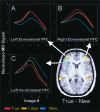Can medial temporal lobe regions distinguish true from false? An event-related functional MRI study of veridical and illusory recognition memory
- PMID: 11287664
- PMCID: PMC31915
- DOI: 10.1073/pnas.081082698
Can medial temporal lobe regions distinguish true from false? An event-related functional MRI study of veridical and illusory recognition memory
Abstract
To investigate the types of memory traces recovered by the medial temporal lobe (MTL), neural activity during veridical and illusory recognition was measured with the use of functional MRI (fMRI). Twelve healthy young adults watched a videotape segment in which two speakers alternatively presented lists of associated words, and then the subjects performed a recognition test including words presented in the study lists (True items), new words closely related to studied words (False items), and new unrelated words (New items). The main finding was a dissociation between two MTL regions: whereas the hippocampus was similarly activated for True and False items, suggesting the recovery of semantic information, the parahippocampal gyrus was more activated for True than for False items, suggesting the recovery of perceptual information. The study also yielded a dissociation between two prefrontal cortex (PFC) regions: whereas bilateral dorsolateral PFC was more activated for True and False items than for New items, possibly reflecting monitoring of retrieved information, left ventrolateral PFC was more activated for New than for True and False items, possibly reflecting semantic processing. Precuneus and lateral parietal regions were more activated for True and False than for New items. Orbitofrontal cortex and cerebellar regions were more activated for False than for True items. In conclusion, the results suggest that activity in anterior MTL regions does not distinguish True from False, whereas activity in posterior MTL regions does.
Figures


References
Publication types
MeSH terms
Grants and funding
LinkOut - more resources
Full Text Sources
Medical
Miscellaneous

